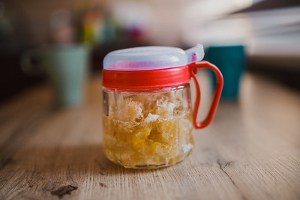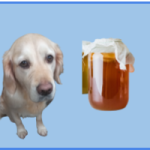
The good news is that raw honey isn’t toxic or poisonous to dogs.
But the bad news is that since raw honey is about 74% sugar it is full of calories and so you need to use raw honey very sparingly with your dog.
And on the calorie front, processed honey is nearly as bad- it contains about 15% fewer calories than raw honey.
If we were just worried about your dog’s weight then my advice would be opt for processed honey every time.
After all , this is the stuff that is in every grocery shop and is the cheapest honey to buy.
But this isn’t an article about your dog’s weight- it is about raw honey.
And to start, let’s find out what raw honey is exactly?
What is raw honey?
This is a little contentious.
Some people use the phrase raw honey, other people use terms such as raw honey and pure honey.
Some people say that raw honey is honey as nature intended it to be.
It is taken straight from the hive and placed in jars which means that it might include bits of honeycomb.
Other people say that raw honey is actually strained through a mesh after it leaves the hive and before it is placed in jars.
Any honey that is strained through a mesh isn’t raw honey because it has been processed and altered in some way.
Instead honey that is only strained through a mesh and hasn’t been heated in anyway isn’t raw honey but pure honey
The honey that most of us spread onto our toast or mix into our green tea is regular or processed honey.
And processed honey is messed around with far more than just being strained.
So having nearly established what raw honey is, in the next section I want to define what processed or regular honey is.
What is regular or processed honey?
Regular honey may have been processed in four different ways- the exact processes differ depending on the manufacturer.
And those four processes are: pasteurisation, filtration, ultrafiltration and added sugar.
Pasteurisation is the process whereby the honey is heated in order to kill any germs and to extend the shelf life of the honey.
The honey will then be filtered which will get rid of any little bits of debris or even air bubbles and will give the honey the smooth and glossy look that we all enjoy.
Ultrafiltration takes this a step further.
It gets rid of ingredients and nutrients in the honey which we can’t necessarily see but which are good for us- such as pollen.
And the final processing that regular honey might be subject to is to have extra sugars added to it.
Which is basically the same as saying that the honey has been watered or sugared down with ingredients like corn or fructose syrup.
With the definitions of these honies out of the way, next I want to look at how raw honey and regular honey differ nutritionally.
How is raw honey different from processed honey?
Apart from the fact that raw honey and processed honey may look slightly different, they may contain very different nutrition.
And this goes way beyond what you will find on any nutrition label because all they show is that raw honey has more calories but less sugar than processed honey.
And that processed honey has more minerals in it such as iron and potassium.
Filtering honey is a bit like performing cosmetic surgery on it.
The final product probably looks nicer but the surgery has taken some things away.
And these “hidden nutrients” are what really separate raw honey from its processed cousin.
And they include pollen, amino acids and vitamins and minerals.
And those differences are important, don’t you think?
So far, things have been very positive about raw honey- it has all been about the upsides.
But in the next section, I want to ferret around to see if raw honey has a dark under belly!
Is raw honey dangerous in any way to dogs?
I bet that subtitle got your attention, didn’t it?
And I am exaggerating a little.
The most dangerous thing about raw honey is the same as any type of honey.
Because it is a form of sugar, it is jam packed with calories.
Use sparingly and don’t start giving it to your dog everyday.
Sugar is dangerous to dogs for two reasons.
Firstly is the obvious one.
If a dog eats too much sugar then they will put on more weight.
But a lesser known evil of sugar or honey is the damage that it can do to your dog’s teeth.
Because of how sticky it is, it will stay in your dog’s mouth and speed up the decaying process…
Next, I want to look at whether one of the “rock stars” in the honey world and whether or not it should be thought of as a type of raw honey.
Is manuka honey a type of raw honey?
This is a very interesting question and I want to start by just going briefly over what Manuka honey is.
It is a honey that is made only in Australia and New Zealand because those are the only two places that the manuka plant grows.
Part of its worldwide appeal is its scarcity- if it can only be produced in two countries, the demand is sure to be strong.
But it has been established that manuka honey has antibacterial qualities.
Well those qualities prove that it must be raw honey then?
No, they don’t.
Remember raw honey is honey that is taken from the hive and placed straight into jars without being messed with.
So manuka honey can be a raw honey but only for a select few who live local to these hives in Australia and New Zealand.
For the rest of us, our manuka honey is processed honey.
From rock star to sick dog.
In the following section, I want to look at some of the bold health claims made by some people within the dog community about the healing power of raw honey.
How might raw honey be used with “sick” dogs?
There are three minor illnesses or ailments that I want to look at with regard to raw honey:
[1] upset stomachs and diarrhea
[2] coughs and sore throats
[3] Allergies
Upset stomachs
Although there are many potential natural remedies for an upset stomach, what could make raw honey part of the cure is that it is a prebiotic.
Prebiotic and probiotics are all forms of good bacteria that live in an animal’s stomach and help to keep the stomach healthy.
A major cause of a stomach upset is when bad bacteria outnumbers good bacteria in the stomach.
In order to get the right balance more good bacteria needs to be added and this can be done in the form of raw honey.
Does it work?
Well there isn’t any scientific evidence of it helping dogs.
Just lots of anecdotes on forums.
However this study fed raw honey to mice and found that it did help to keep their stomachs healthy!
And this study on children showed that raw honey helped children with diarrhea recover more quickly than those who didn’t eat raw honey.
Coughs and sore throat
Secondly, is the ability of raw honey to treat coughs and sore throats in a dog.
To be honest this is a bit of a confusing one.
Raw honey is known to contain anti- bacterial properties and kennel cough is a bacterial and viral infection and so the antibacterial qualities should help your dog.
Surprise, surprise there is no studies on the use of honey for dogs with a cough.
However, a small study done with children, showed that a mix of honey and milk was as effective at relieving a cough as over the counter medications.
Allergies
Earlier, I pointed out that many varieties of raw honey are known to contain pollen, whereas honey that has been highly processed doesn’t contain any.
But how can pollen help with an allergy instead of making it worse?
It’s thought that the tiny amount of pollen contained in raw honey once eaten causes a dog’s immune system to create antibodies against the pollen, which helps reduce the impact of pollen which is in the air.
However, although there is lots of “noise” from the dog community about how effective local raw honey can be to treat allergies in dogs, I cannot find any scientific evidence to back it up.
And, it seems, there is no reliable evidence that eating local honey will help a person who suffers from hayfever!
Photo credits
¹ Photo by Nenad Stojkovic on Flickr





